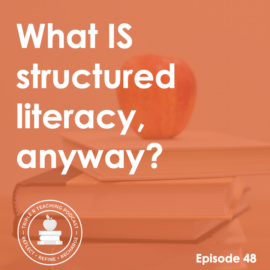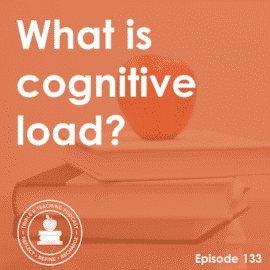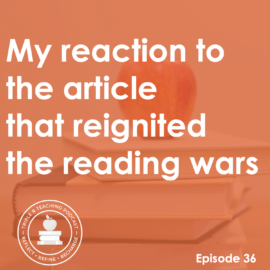TRT Podcast #123: How to add speech to print elements to your phonics instruction
Curious about speech to print but not ready to take the plunge? These are simple ways to add speech to print elements to traditional phonics instruction.
Full episode transcript
Hello! Anna Geiger here from The Measured Mom, and this week we're going to talk again about print to speech versus speech to print.
Last week I teamed up with Melissa and Lori Love Literacy. They had an interview about speech to print, and I had a quick episode comparing print to speech versus speech to print. Remember that I said that a better way to refer to these approaches is traditional phonics instruction, such as Orton-Gillingham which is print to speech, versus structured linguistic literacy, which includes programs you may be familiar with like Reading Simplified, EBLI, Phono-Graphix, and SPELL-Links.
Today I want to talk to you about what you might do if you're intrigued by structured linguistic literacy, but you're not ready to go all in. It is quite a commitment because it really changes your scope and sequence big time, and it changes your pacing. It's really very different from a traditional phonics approach.
So what can you do if you're not ready to do that or aren't sure you want to, but you want to incorporate some of the really good things in the structured linguistic literacy approach? That's what we're going to talk about today.
One easy change you can make is to say this to your students when they are listening for phonemes and repeating words that have particular phonemes. Instead of saying, "What sound did you hear in each of these words," say, "What sound did you SAY in each of these words?" This helps them associate the sound with something they did with their mouth.
Something else to remember is that you can start having kids build words from a very early age, even in preschool. I just finished reading a book called Making Speech Visible, by Dr. Jeannine Herron, and she talks about having that be the way to reading - by spelling! Actually starting with spelling, giving kids letter tiles and having them build words.
Another thing to think about as you are maybe incorporating elements of structured linguistic literacy is to focus more on the sounds than the letter names. I'm not saying you shouldn't teach letter names when you teach sounds, I personally think that that's a good idea, but when you're doing the building with words, think about referring to the tiles as their sound versus the letter. So if a child has three tiles, M, A, T, instead of saying move the M, you could say, move the /m/, find the /ă/, find the /t/, and that can help them really focus on what those letters represent.
Another thing to remember is that you want to start very early with teaching vowels and consonants that can be combined to form words. You don't want to have to wait halfway through kindergarten before kids can start to blend and spell. You want to be doing that very early, and you can. You can start that the second week of school if you are teaching consonants and vowels that can be combined to make words.
Another thing to think about is to use letter tiles versus blank tiles as soon as possible. So as soon as you teach those initial consonants and vowels, the first ones that you teach, put those letter names on the tiles versus doing this without. Because as we know, phonemic awareness instruction is much more effective if we have letters versus just blank tiles.
Another thing to keep in mind is that we should spend very little time on bigger speech sounds, such as syllables. We want to focus on phonemes right from the start, and we learned about that in our episode with Dr. Susan Brady.
So even if you're teaching preschoolers, phonemes are your main focus. I personally don't have a problem with doing syllables and rhyming in moderation in preschool. However, and this is very interesting, The National Reading Panel found the greatest effect size for phonemic awareness instruction when it was taught to preschoolers. So we don't have to wait until kids can count syllables or rhyme words, we can do phonemic awareness very early on. And again, phonemic awareness develops really well when you are spelling words using just a few letters and then blending those sounds, reading the words back.
You want to do a lot of word building and word chaining from the beginning. So not only are you having kids build words, like building the word mat with /m/ /ă/ /t/, you're also going to have them switch out letters and replace them with other letters.
You could say, "Let's switch out a sound. You've got the word 'mat,' let's change that word to 'sat.' Which sound do we need to switch?" And then show them that they're going to move the /m/ out and put the /s/ in.
So those are just a few things to think about.
One more thing is to consider the pace of your phonics program. Remember that in structured linguistic literacy, they actually teach quite a few spellings at once. Now, they repeat them over the year, so just because they teach multiple spellings for long O in kindergarten doesn't mean they're not going to review in first grade. Knowing that this works for so many children, I think we don't have to be afraid of introducing multiple spellings at once.
For example, if I'm teaching /ō/, maybe I would rather teach just O by itself, an O constant E. But when I'm teaching vowel teams, it probably makes sense to teach a bunch at a time, because some of them are very rare anyway. So maybe I'll teach OA as in soap, OW as in snow, and OE as in toe. I might do all three at once.
So think about that. Think about if you can improve your pacing, because the sooner you get through all the phonics skills, the sooner kids are going to be able to read authentic text.
There's probably a lot more we can say, but I think that's a good starting point.
I hope you'll check out Melissa and Lori's episode from last week so you can learn more about structured linguistic literacy from the experts. And don't forget to head to the show notes, because there I'm going to link to some YouTube videos that will really help you dive deep to see if structured linguistic literacy is something that you want to try. You can find the show notes for today's episode at themeasuredmom.com/episode123. Talk to you next time!
Sign up to receive email updates
Enter your name and email address below and I'll send you periodic updates about the podcast.
Related links

- Talking phonemic awareness with Dr. Susan Brady
- Making Speech Visible, by Dr. Jeannine Herron
- Teaching Reading with a Speech to Print Approach: YouTube video with Dr. Jan Wasowicz
- Speech to Print: Is There a Third Way? YouTube video with Dr. Marnie Ginsberg
- Answering Your Questions about Speech to Print: YouTube video with Nora Chahbazi








Elizabeth Montes
Hello,
I just wanted to say THANK YOU!! for your podcast. I am just a mom trying to find a way to help my son and you have been a true guide. I have learned so much from you and Melissa & Lori’s podcasts. Thank you again so much!
Anna Geiger
Thank you so much, Elizabeth! I really appreciate that you took the time to let me know!